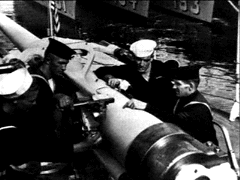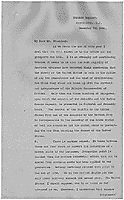At left: First Page of Dec. 7 Letter.
All 17 pages can be found at
Nail Database as Winston Churchill to Franklin D. Roosevelt
Unrestricted. (NLR-MR-FDRWSC-1940-2D)
 At the December 17 press conference, FDR sought to suggest a way to give the British what they needed without referring to loans, credits, or subsidies. FDR compared lend-lease to a fire hose that should be lent to a neighbor to put out a fire. In a fireside chat twelve days later, FDR began his speech by using strong words regarding the Nazi threat in Europe. He stated that they would "enslave the whole of Europe" and "dominate the rest of the world." So, in response, the U.S. should not live "at the point of a gun", but should be the "arsenal of democracy." Churchill wrote FDR a note to thank him for presenting the European cause to the American people it such a way. The reaction to FDR's speech can be found in both the press and the Congress. Americans were "comfortable with the idea of protecting their security without going to war." However, to implement lend-lease, FDR had to gain Congressional approval. FDR wanted the bill to allow for debate within Congress to seem intense without Congress touching on wider issues of foriegn policy. He also wanted the bill to remain flexible so that he would not be limited regarding "which nations to aid, what goods to send, and what to ask as repayment." In the end, he achieved success. The bill passed with only four amendments. The lend-lease program helped Britain by putting America's economic strength to work. The program provided between forty-two and fifty billion WW II dollars worth of aid to the war against the Axis powers. In this way, it was a form of economic warfare. It was what Churchill meant when he referred to nonbelligerency in his first letter to FDR. At this point in the war, FDR had moved the U.S. to helping the war effort with all means except sending armed forces. (8)
At the December 17 press conference, FDR sought to suggest a way to give the British what they needed without referring to loans, credits, or subsidies. FDR compared lend-lease to a fire hose that should be lent to a neighbor to put out a fire. In a fireside chat twelve days later, FDR began his speech by using strong words regarding the Nazi threat in Europe. He stated that they would "enslave the whole of Europe" and "dominate the rest of the world." So, in response, the U.S. should not live "at the point of a gun", but should be the "arsenal of democracy." Churchill wrote FDR a note to thank him for presenting the European cause to the American people it such a way. The reaction to FDR's speech can be found in both the press and the Congress. Americans were "comfortable with the idea of protecting their security without going to war." However, to implement lend-lease, FDR had to gain Congressional approval. FDR wanted the bill to allow for debate within Congress to seem intense without Congress touching on wider issues of foriegn policy. He also wanted the bill to remain flexible so that he would not be limited regarding "which nations to aid, what goods to send, and what to ask as repayment." In the end, he achieved success. The bill passed with only four amendments. The lend-lease program helped Britain by putting America's economic strength to work. The program provided between forty-two and fifty billion WW II dollars worth of aid to the war against the Axis powers. In this way, it was a form of economic warfare. It was what Churchill meant when he referred to nonbelligerency in his first letter to FDR. At this point in the war, FDR had moved the U.S. to helping the war effort with all means except sending armed forces. (8) In a four thousand words and nineteen paragraphs, Churchill expressed the state of the war and what Britain needed in order to continue to fight in an effective way. The letter was carefully written and strongly worded. Churchill focused on the importance of the sea in the future of the war, in particular, shipping and supply. He stated, "It is therefore in shipping and in the power to transport across the ocean, particulary in the Atlantic Ocean, that in 1941 the crunch of the whole war will be found." Churchill also addressed the issue that Britain could no longer pay for supplies in cash. This letter, in addition to public tactics by the British government, disclosures of their financial state, and Roosevelt having time away from Washington, all led to FDR's action in the form of a press conference on December 17, 1940. (7) This press conference would lead to a formalized lend-lease program in the form of House Resolution 1776.
In a four thousand words and nineteen paragraphs, Churchill expressed the state of the war and what Britain needed in order to continue to fight in an effective way. The letter was carefully written and strongly worded. Churchill focused on the importance of the sea in the future of the war, in particular, shipping and supply. He stated, "It is therefore in shipping and in the power to transport across the ocean, particulary in the Atlantic Ocean, that in 1941 the crunch of the whole war will be found." Churchill also addressed the issue that Britain could no longer pay for supplies in cash. This letter, in addition to public tactics by the British government, disclosures of their financial state, and Roosevelt having time away from Washington, all led to FDR's action in the form of a press conference on December 17, 1940. (7) This press conference would lead to a formalized lend-lease program in the form of House Resolution 1776.